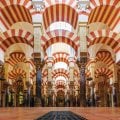MOSQUE-CATHEDRAL (MEZQUITA-CATEDRAL)
Mosque-cathedral built in three phases, considered one of the most grandiose religious monuments in the Arab world
Unmistakable when you walk along the Guadalquivir, as it is located right in the heart of the Juderia! You enter the large patio (known as the Orange Tree Courtyard) through the Postigo de los Deanes and access the mosque through the Saint Catherine's Gate.
This double monument (mosque and cathedral) bears witness to the efforts, fortunately not crowned with success, that the Christian kingdom, delivered from the Moors, made to eradicate all traces of Muslim influence. The location of the monument was not chosen at random. It was first occupied by a Roman temple dedicated to Janus, then the Visigoths erected their own temple (some remains remain).
The mosque was built in three phases between the mid-8th and early 11th centuries. Considered to be one of the most grandiose religious monuments in the Arab world, it dominated a complex where mosques numbered in the dozens.
In 1236, after the conquest of the city and the flight of the Muslims to North Africa, Ferdinand III the Saint ordered its transformation into a church. The 19 gates leading to the courtyard were closed (except for the Palm Gate). Chapels were built around the monument and the minaret was transformed into a bell tower.
In 1523, Bishop Alonso Maurique decided to make a vast cathedral out of the original columns. The city council opposed the project, but Charles V agreed. Three years later, he expressed his reluctance at the "disfigurement" of this jewel, but it was still too late.
The final result is magnificent: the solemn cathedral, whose 19 naves supported by double-flight arches rest on more than 800 columns, adapts to the subtleties of oriental frescoes.
Classified as a national monument in 1882, it was inscribed on the UNESCO World Heritage List in 1984 and has since been elevated to the rank of property of outstanding universal value in June 2014, due to the continued religious use of the building, which largely explains its preservation.
Minaret (or torre del Alminar). It is an essential part of the Cordoba landscape that rises imposingly above the city. Originally a Muslim minaret and now a tower, its appearance reflects the various architectural contributions of successive builders. You enter through the Pardon Gate and from the top of the tower, the view of the city is splendid.
Cour des Orangers (patio de los Naranjos). Palm trees were planted here in the 13th century, orange trees in the 15th century, olive trees and cypresses in the 18th century. The faithful performed their ablutions in fountains fed by a huge cistern located under the courtyard.
The Prayer Room (sala de Oración). This miracle of Islamic architecture has about 850 columns of jasper, marble and granite that are coloured in various colours (red, white, blue, purple).
Richly decorated with marble panels, the mihrab (facing Mecca) is opposite the entrance. Its blue or pink marble mosaics were offered to the Caliphs of Cordoba by Emperor Constantine VII.
The Villaviciosa chapel and the treasure of the cathedral crown the visit.
Visit. The mosque-cathedral mosque is open free of charge from 8:30 to 9:15 a.m. every day except Sundays and holidays. This is not strictly speaking a free visit but hours of worship. The visit must of course respect the proper conduct of the cult.
Did you know? This review was written by our professional authors.
Book the Best Activities with Get Your Guide
Members' reviews on MOSQUE-CATHEDRAL (MEZQUITA-CATEDRAL)
The ratings and reviews below reflect the subjective opinions of members and not the opinion of The Little Witty.
Find unique Stay Offers with our Partners






Je l'ai visitée avec audioguide, c'était un peu difficile de s'y retrouver avec le petit plan fourni.
Une visite guidée est certainement préférable